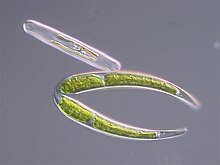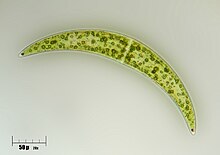Closterium
| Closterium | |
|---|---|

| |
| Closterium sp. | |
| Scientific classification | |
| Kingdom: | |
| Division: | |
| Class: | |
| Order: | |
| Family: | |
| Genus: | Closterium
|
| Species | |
|
See text | |
Closterium is a genus of unicellular charophyte green algae in the family Closteriaceae.[1]
Taxonomy
Closterium regulare was first described from Lower Normandy by Brebisson.[2]
Species



Closterium includes the following species:
- C. acerosum
- C. calosporum
- C. cornu
- C. ehrenbergii
- C. gracile
- C. incurvum
- C. littorale
- C. lunula
- C. moniliferum
- C. navicula
- C. peracerosum
- C. peracerosum-strigosum-littorale complex
- C. pleurodermatum
- C. pusillum
- C. selenastrum
- C. setaceum
- C. spinosporum
- C. tumidum
- C. venus
- C. wallichii
Reproduction
Asexual: binary fission from a partitioned parent cell.
Sexual: Conjugation to form a hypnozygote.
The Closterium peracerosum-strigosum-littorale (C. psl) complex is a unicellular, isogamous charophycean alga group that is the closest unicellular relative to land plants. These algae are capable of forming two types of dormant diploid zygospores. Some populations form zygospores within single clones of cells (homothallic), whereas others form zygospores between different clones of cells (heterothallic). The heterothallic strains have two mating types, mt(-) and mt(+). When cells of opposite mating types are mixed in a nitrogen-deficient mating medium, mt(-) and mt(+) cells pair with each other and release protoplasts. This release is then followed by protoplast fusion (conjugation) leading to formation of a diploid zygospore. Sex pheromones termed protoplast-release inducing proteins produced by mt(-) and mt(+) cells facilitate this process.[3]
A homothallic strain of Closterium forms selfing zygospores via the conjugation of two sister gametangial cells derived from one vegetative cell.[4] Conjugation in the homothallic strain occurs mainly at low cell density and is regulated by an ortholog of a heterothallic sex-specific pheromone.
Although self-fertilization employs meiosis, it produces minimal genetic variability. Homothallism is thus a form of sex that is unlikely to be adaptively maintained by a benefit related to producing variability. However, homothallic meiosis may be maintained in Closterium peracerosum as an adaptation for surviving under stressful conditions such as growth in nitrogen depleted media at low cell density. A proposed adaptive benefit of meiosis is the promotion of homologous recombinational repair of DNA damages that can be caused by a stressful environment [5]
References
- ^ See the NCBI webpage on Closterium. Data extracted from the "NCBI taxonomy resources". National Center for Biotechnology Information. Retrieved 2007-03-19.
- ^ Carter, C.F. and Williamson, D.B. (2008) A rediscovered UK desmid: Closterium regulare Breb The Phycologist. Autumn 2008 No.75:24
- ^ Sekimoto H, Satoh S, Fujii T (1990). "Biochemical and physiological properties of a protein inducing protoplast release during conjugation in theClosterium peracerosum-strigosum-littorale complex". Planta. 182 (3): 348–54. doi:10.1007/BF02411384. PMID 24197184.
- ^ Tsuchikane Y, Kokubun Y, Sekimoto H (2010). "Characterization and molecular cloning of conjugation-regulating sex pheromones in homothallic Closterium". Plant Cell Physiol. 51 (9): 1515–23. doi:10.1093/pcp/pcq110. PMID 20656896.
- ^ Mirzaghaderi G, Hörandl E (2016). "The evolution of meiotic sex and its alternatives". Proc. Biol. Sci. 283 (1838). doi:10.1098/rspb.2016.1221. PMC 5031655. PMID 27605505.
External links
Scientific references
Scientific databases
- Guiry, M.D.; Guiry, G.M. "Closterium". AlgaeBase. World-wide electronic publication, National University of Ireland, Galway.
- AlgaTerra database
- Index Nominum Genericorum
